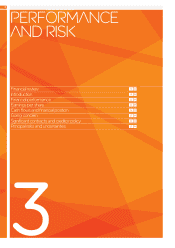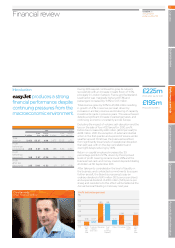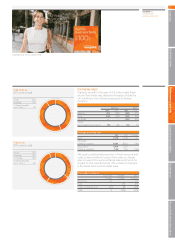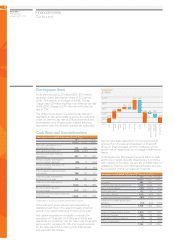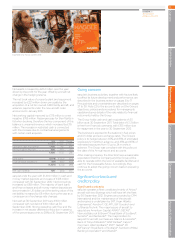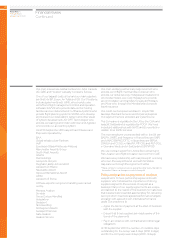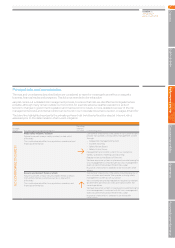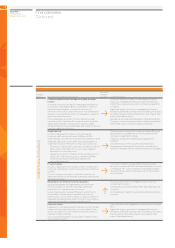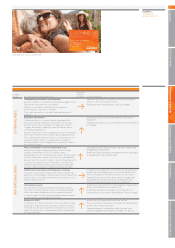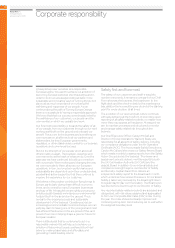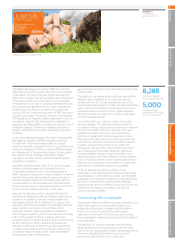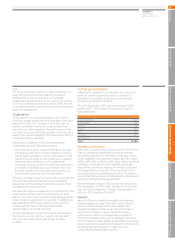EasyJet 2011 Annual Report Download - page 27
Download and view the complete annual report
Please find page 27 of the 2011 EasyJet annual report below. You can navigate through the pages in the report by either clicking on the pages listed below, or by using the keyword search tool below to find specific information within the annual report.
easyJet plc
Annual report
and accounts 2011
Overview Business review Performance and risk Corporate responsibility Governance Accounts & other information
25
Net assets increased by £204 million over the year
driven by the profit for the year offset by a small net
change in the hedging reserve.
The net book value of property plant and equipment
increased by £221 million driven principally by the
acquisition of a net ten owned A320 family aircraft, and
advance payments under the new aircraft order
announced in January 2011.
Net working capital improved by £175 million to a net
negative £765 million. Passengers pay for their flights in
full when booking, therefore the key component of this
balance is unearned revenue, which increased by £115
million. The increase in restricted cash is connected
with this increase due to contractual arrangements
with certain card acquirers.
2011 2010 Change
£ million £ million £ million
Cash and cash equivalents 1,100 912 188
Money market deposits 300 260 40
1,400 1,172 218
Bank loans (1,079) (1,057) (22)
Finance lease obligations (221) (155) (66)
(1,300) (1,212) (88)
Net cash / (debt) 100 (40) 140
easyJet ends the year with £1,400 million in cash and
money market deposits; an increase of £218 million
compared with 30 September 2010. Net borrowings
increased by £88 million. The majority of bank loans
and finance leases and all money market deposits are
denominated in US dollars and the sterling value of this
net liability increased by £8 million during the year as a
consequence of exchange rate changes.
Net cash at 30 September 2011 were £100 million
compared with net debt of £40 million at 30
September 2010. Strong operating cash flow and the
increase in net assets delivered a reduction in gearing
of five percentage points to 28% at 30 September 2011.
Going concern
easyJet’s business activities, together with factors likely
to affect its future development and performance, are
described in the business review on pages 8 to 17.
Principal risks and uncertainties are described on pages
27 to 30. Note 22 to the accounts sets out the Group’s
objectives, policies and procedures for managing its
capital and gives details of the risks related to financial
instruments held by the Group.
The Group holds cash and cash equivalents of £1.1
billion as at 30 September 2011. Total debt of £1.3 billion
is free from financial covenants, with £155 million due
for repayment in the year to 30 September 2012.
The business is exposed to fluctuations in fuel prices
and US dollar and euro exchange rates. The Group’s
policy is to hedge between 65% and 85% of estimated
exposures 12 months in advance, and 45% and 65% of
estimated exposures from 13 up to 24 months in
advance. The Group was compliant with this policy at
the date of this Annual report and accounts.
After making enquiries, the Directors have a reasonable
expectation that the Company and the Group will be
able to operate within the level of available facilities and
cash for the foreseeable future. Accordingly, they
continue to adopt the going concern basis in preparing
the accounts.
Significant contracts and
creditor policy
Significant contracts
easyJet operates a fleet constituted mainly of Airbus*
aircraft with two Boeings which will have left the fleet
by 30 September 2012. Engines are provided by CFM
International and the maintenance of the aircraft
andengines is undertaken by SRT, Virgin Atlantic
Engineering*, Aerotron*, GE, MTU, BF Goodrich and
Lufthansa Technik. The major lessors of aircraft to
easyJet are Amentum Capital, AWAS*, GECAS*,
Nomura Babcock & Brown*, Royal Bank of Scotland*,
Sumisho*, and Santander*. The major lenders to
easyJet for aircraft purchase are Alliance & Leicester*,
Bank of Tokyo-Mitsubishi*, BNP Paribas*, Calyon*,
Commerz, HSH Nordbank*, KfW*, Natixis*, PK
AirFinance*, Royal Bank of Scotland*, Sumitomo Mitsui
Banking Corporation* and WestLB*.
Example only. Not a current offer.





